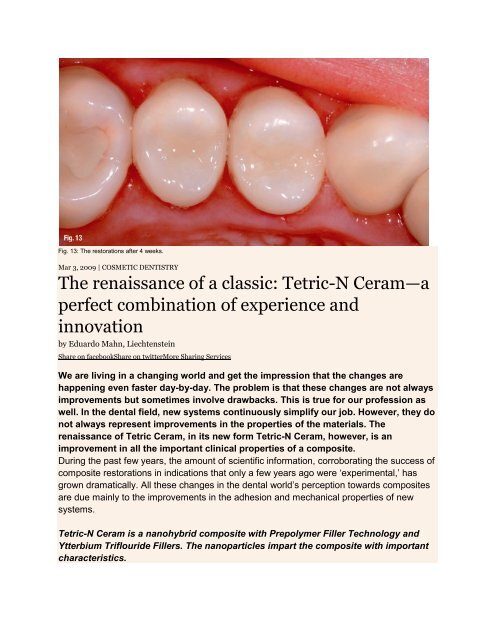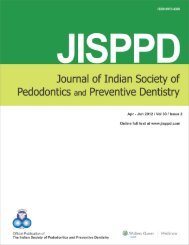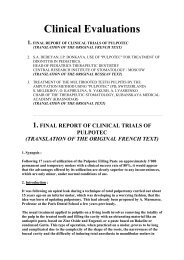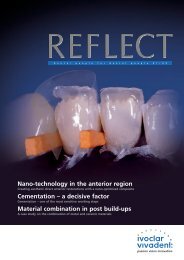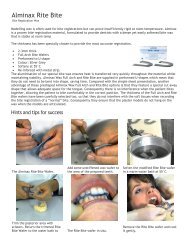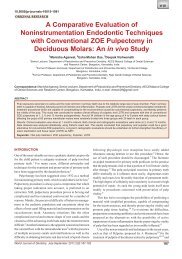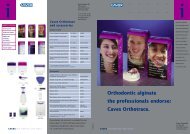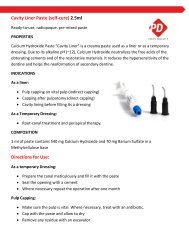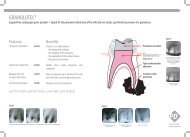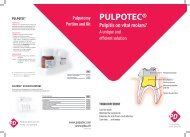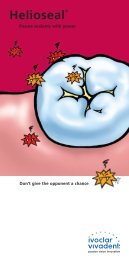View File - universaldental.com.pk
View File - universaldental.com.pk
View File - universaldental.com.pk
- No tags were found...
Create successful ePaper yourself
Turn your PDF publications into a flip-book with our unique Google optimized e-Paper software.
Fig. 13: The restorations after 4 weeks.<br />
Mar 3, 2009 | COSMETIC DENTISTRY<br />
The renaissance of a classic: Tetric-N Ceram—a<br />
perfect <strong>com</strong>bination of experience and<br />
innovation<br />
by Eduardo Mahn, Liechtenstein<br />
Share on facebookShare on twitterMore Sharing Services<br />
We are living in a changing world and get the impression that the changes are<br />
happening even faster day-by-day. The problem is that these changes are not always<br />
improvements but sometimes involve drawbacks. This is true for our profession as<br />
well. In the dental field, new systems continuously simplify our job. However, they do<br />
not always represent improvements in the properties of the materials. The<br />
renaissance of Tetric Ceram, in its new form Tetric-N Ceram, however, is an<br />
improvement in all the important clinical properties of a <strong>com</strong>posite.<br />
During the past few years, the amount of scientific information, corroborating the success of<br />
<strong>com</strong>posite restorations in indications that only a few years ago were ‘experimental,’ has<br />
grown dramatically. All these changes in the dental world’s perception towards <strong>com</strong>posites<br />
are due mainly to the improvements in the adhesion and mechanical properties of new<br />
systems.<br />
Tetric-N Ceram is a nanohybrid <strong>com</strong>posite with Prepolymer Filler Technology and<br />
Ytterbium Triflouride Fillers. The nanoparticles impart the <strong>com</strong>posite with important<br />
characteristics.
If we analyse the history of <strong>com</strong>posites, look at the problems they had in the beginning and<br />
the improvements that have been realised to date, we understand how much has been<br />
achieved.<br />
Below are some of the major improvements shown by the example of Tetric-N Ceram:<br />
Microfilled & hybrid <strong>com</strong>posites<br />
The first macrofilled <strong>com</strong>posites were clinically unsuccessful because of their inadequate<br />
surface properties and poor wear resistance. Microfilled <strong>com</strong>posites brought a breakthrough<br />
because they were the first materials to be sufficiently wear-resistant and maintained an<br />
acceptable surface quality during clinical service. Hybrid <strong>com</strong>posites represented another<br />
step forward with respect to the mechanical properties of <strong>com</strong>posite materials.<br />
Tetric-N Ceram, with a mean particle size of
secondary caries, excess or inadequate quantities of material, air bubbles and other<br />
imperfections. The minimum radiopacity of restorative materials has been defined to <strong>com</strong>ply<br />
with the radiopacity of dental enamel (200% of aluminium [%Al]). Nevertheless, only a few<br />
<strong>com</strong>posite restoratives demonstrate a radiopacity higher than 250% Al. Tetric N-Ceram<br />
features 400% Al in all the shades and 280% Al in the flowable version.<br />
Clinical case<br />
A 28-year-old female patient presented to our practice with the request to remove an<br />
amalgam filling in the first premolar of the upper left quadrant. The initial situation showed a<br />
defective amalgam filling with secondary caries, especially in the mesial part. The<br />
<strong>com</strong>posite filling in tooth 25 seemed to be caries-free from the occlusal view (Fig. 1). The X-<br />
ray image did not reveal any caries in the proximal region. After removing the amalgam, the<br />
caries in the mesiocervical of tooth 25 was obvious. Therefore, we decided to replace the<br />
restorations. After the existing restorations had been removed, the cavity margins were<br />
prepared with an oscillating instrument (Fig. 2). The tips are diamond-coated on only one<br />
side to prepare the tooth without the risk of causing iatrogenic damage to the adjacent<br />
healthy tooth structure. The treatment field was isolated using OptraDam. The threedimensional<br />
design enables treatment without clamps (Fig. 3).<br />
Figs. 1–4: Defective amalgam filling with secondary caries in tooth 24. The <strong>com</strong>posite filling<br />
in tooth 25 seems acceptable from the occlusal aspect (Fig. 1). The cavity margins were
prepared with an oscillating instrument to prevent iatrogenic damage to the adjacent healthy<br />
tooth structure (Fig. 2). The treatment field was isolated with OptraDam (Fig. 3). A glass<br />
ionomer cement liner, Vivaglass CEM, was applied and light cured (Fig. 4).<br />
The areas closer to the pulp were protected with Vivaglass liner, a light-curing glass<br />
ionomer cement. The special consistency allows very precise application (Fig. 4). Then, the<br />
enamel margins were etched selectively with 37% phosphoric acid for 30 seconds (Fig. 5).<br />
The etching gel was applied and distributed quickly on the dentin, where it was allowed to<br />
react for only 10 seconds to avoid the frequent technical error of overetching the dentin (Fig.<br />
6). Following, Tetric-N Bond was applied. It is important to make sure that all the cavity<br />
surfaces are covered with the adhesive. Therefore, in some special cases, such as for very<br />
small or too large cavities where the application is more difficult, the stipulated agitation time<br />
of 10 seconds has to be prolonged (Fig. 7). Tetric N-Bond was polymerised with the<br />
bluephase G2 curing light in the Low Power mode to avoid overheating the pulp. If such a<br />
powerful new generation LED unit is used, it is crucial to have the option of different<br />
programmes to cover the different indications (Fig. 8).<br />
Figs. 5–8: The enamel margins were etched selectively for 30 seconds (Fig. 5). The<br />
phosphoric acid was allowed to react for only ten seconds on dentin (Fig. 6). Tetric-N Bond<br />
was applied (Fig. 7). The adhesive was polymerised with the bluephase G2 curing light in<br />
the Low Power mode (Fig. 8).
Once we placed the matrix (OptraMatrix), we built up the proximal cavity walls, thus creating<br />
tight proximal contacts. Due to the 10 µm thick OptraMatrix, it is easy to achieve tight<br />
contact points (Figs. 9, 10). These functional contacts are the key to prevent periodontal<br />
damage, food impact and the resulting secondary caries. After finishing tooth 24, the same<br />
procedure was applied on tooth 25 (Fig. 11). Predictable, high-quality results, with regard to<br />
proximal contacts and occlusal surfaces prior to polishing, are achieved due to the<br />
incremental technique and the easy handling properties of the material (Fig. 12). Finally, the<br />
restorations were finished and polished to achieve an exceptionally aesthetic appearance.<br />
Due to the excellent final gloss and the chameleon effect of the <strong>com</strong>posite, the restorations<br />
are almost invisible (Fig. 13).<br />
Figs. 9–12: OptraMatrix was placed and the proximal cavity walls were built up (Figs. 9 &<br />
10). After finishing tooth 24, the same technique was applied on tooth 25 (Fig. 11). The<br />
restorations after the last layer was applied (Fig.12)


